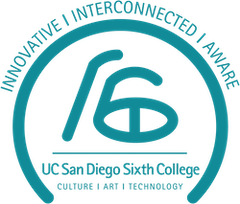Tijuana Estuary Project
Read about Sixth College students who participated in a service learning project in the Tijuana Estuary.
Sixth College helps pave the way toward a sustainable future
Armed with hammers, screwdrivers, and brad fasteners, 20 Sixth College student resident advisors (RAs) ventured out into the mid-day sun against the backdrop of the Tijuana River National Estuarine Research Reserve, a 2,500-acre saltwater marsh created where the Tijuana River joins the Pacific Ocean.
The estuary is one of 3 in California and 27 in the United States. Over 90% of U.S. wetlands have disappeared. The estuary provides our coastal community protection from flooding. It is a nursery for fish and a home to wildlife. And it has the natural ability to clean toxins from water flowing in from the watersheds before entering the ocean. Today, loose soil and toxic waste pouring into the Tijuana Estuary through the border canyons is destroying this ecological preserve.
The RAs paired up in the neighborhood of San Bernardo, nestled in the Los Laureles Canyon section of the estuary, to construct 150 pervious paver frames, which will make 1500 pervious pavers.
With other paving materials, water hits the surface and then naturally flows to the lowest point (in this case , the estuary). But pervious pavers allow water to filtrate through the surface and down to the ground beneath. As an additional benefit, the porous material is a good place for bacterial growth that naturally cleans water runoff. For San Diego, this means less sediment will cascade into the estuary. And for Tijuana, this means groundwater aquifers can be recharged with clean water.
For the 20 RAs, the service learning experience - volunteer work with and educational component - in the Tijuana Estuary was the first step toward educating themselves about sustainability and the environment so they can encourage students and peers to conserve. "I hope this will develop into an ongoing relationship with the Tijuana Estuary, giving Sixth College students an opportunity to complete the service learning Practicum requirement," said Sixth College Practicum Director Dr. Eboneé Williams.
"We study a lot about the difference between Tijuana and San Diego, and just how drastic it is to go from one to the other," said Urban Studies and Planning major Morgan Chee. "We think of the border as this brick wall, but to see [the estuary] that actually does carry through, and is both of ours to share, is really meaningful."
"Doing work in the estuary helped remind me that every little opportunity we have as people to save and not waste our resources will make the environment last that much longer in the future," said RA Scott Tsuda.
Sixth College residential life is going green this year. RAs have formed the Resident Advisor Sustainability Initiatives Committee (RASIC) to reach out and inspire not only other Sixth College students, but students, faculty and staff around campus to get on board with sustainability initiatives. Their theme is: "Mission Possible: Leave the world better than you found it."
The new committee has also partnered with Alonso Noble in Facilities Management and Kristin Blackler of the UCSD Environment and Sustainability Initiative.
"We're focusing on recycling in fall quarter. That includes reuse," said Chee. "In winter quarter, we're going to do energy conservation. In spring quarter, we want to focus on smart growth. We'll be bringing in things in an environmentally smart way."
"We really tried to look at things so that they made sense during the time of year," said Assistant Resident Dean Jayne Smith. "It is mission possible!"
- By Beverly Gallagher
For more information, contact Lynne McMullin.
